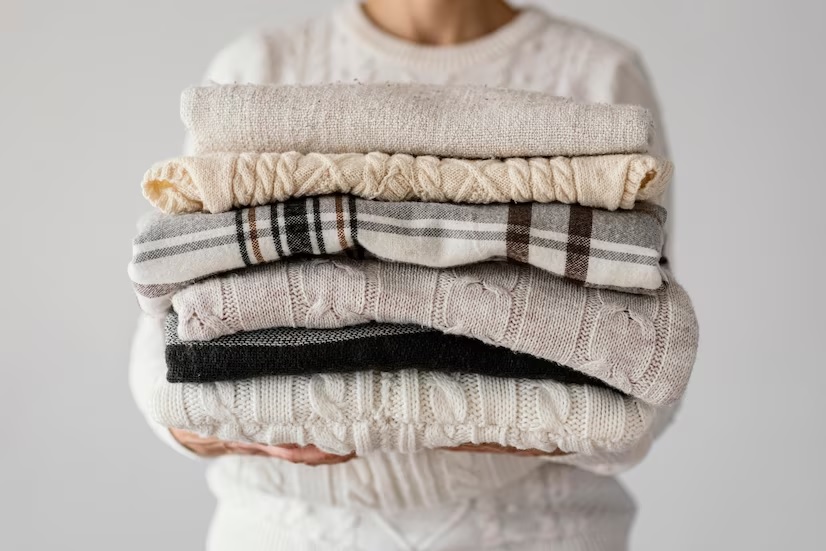My grandma often used to say that sweaters can be an investment that would last forever, only if you know how to take care of them properly. Now that I buy my favorite Chanel sweaters and want them to last a lifetime, it reminds me of all the tips and tricks she applied to increase the lifespan of our sweaters back then.
So if you are wondering how long do sweaters last, then you are at the right place. In this blog, I have compiled the tips and tricks of caring for knitwear, along with recommended tools that I learned from my grandma to improve the longevity of my sweaters and reduce the need for new purchases.
With fall approaching, it’s time to bring out your favorite sweaters. As you know sweaters are essential pieces of clothing, especially during sweater weather. To ensure that your sweaters last longer and stay in good condition, it’s crucial to practice proper care and maintenance. However, different materials require different care, so it’s essential to know how to wash and store them properly. And It’s important to note that care instructions may vary, so always check the label first before applying these tips.
Keep Your Sweaters Looking Fresh and Presentable, By Regularly Mentanence.
When it comes to maintaining your sweaters, it’s important to be proactive.
1. One of the most common issues is the accumulation of hair and lint, which can be easily addressed by using a lint roller or a fabric brush. Taking small steps such as regularly removing hair and lint can make a significant difference in extending the lifespan of your favorite sweaters.
2. It’s essential to store your sweaters properly when they’re not in use. Especially if you own Chanel knit sweaters like me, I Suggest you Fold them neatly instead of hanging them. It can help prevent stretching and maintain their shape.
3. You can also use mothballs or cedar chips to protect your sweaters from potential damage caused by moths or other insects.
Incorporating these simple care practices into your routine will not only prolong the life of your sweaters but also save you money in the long run.
Inspect It Every Few Wears For Any Snags.
It’s common for sweaters to develop snags over time. If you notice any snags, a simple technique can help prevent them from turning into larger holes.
Start by turning your sweater inside out, exposing the snagged area. Then, gently use a crochet hook to carefully pull the snag through to the other side of the fabric. By doing this, you can effectively address the snag and prevent it from causing additional damage or creating larger holes.
Regularly checking for and addressing snags in this manner is a proactive approach to sweater care.
Avoid Hanging Sweaters and Opt for Folding Them Instead.
To care for your sweaters, avoid hanging them as it can lead to stretching, drooping, and shoulder dimples. Instead, fold them to maintain their shape. Here’s a step-by-step guide on how to properly fold and pack sweaters:
1. Lay your sweater flat on a table or surface, with the front side facing down.
2. Fold each arm inward towards the center of the sweater.
3. Fold half of the sweater inwards, followed by the other half, so that they meet in the middle.
4. Starting from the bottom of the sweater, fold it up once or twice, depending on its length.
5. Flip the sweater over, and it’s ready to be stored or packed away.
By employing this folding technique, you can preserve the shape and quality of your sweaters while optimizing space and keeping them organized.
Just in case you have enough space in your closets but lack a dresser, there is an alternative option. Fold the sweaters in half first and then hang them over the bar of a hanger.
How to Wash Knitted Sweaters in respect to its Material.
When it comes to washing, be gentle and avoid picking off pills with your fingers. Use specialized tools like electric fabric shavers, sweater stones, or fabric combs to remove pills. Different sweater materials require different washing methods.
WOOL:
Wool items don’t need frequent washing, so air them out before storing them. The lanolin in wool helps eliminate odors, making airing out more effective than washing. For small stains, use cold water or wool-specific shampoo. Wearing an undershirt beneath sweaters can extend the time between washes. Dry cleaning is not always necessary, as it can be harsh on wool.
When hand washing wool: Use lukewarm water and wool-specific detergent. Gently agitate, soak, rinse, and roll in a towel to remove excess water. Lay flat to dry and reshape while damp.
If you choose to machine wash: Turn the sweater inside out, place it in a mesh bag, use a gentle cycle with wool detergent, and dry flat while reshaping. Release wrinkles with a steamer instead of an iron to sanitize the wool.
By following these care instructions, you can maintain the quality and appearance of your wool items without subjecting them to unnecessary washing or potentially damaging dry cleaning methods.
CASHMERE
Caring for cashmere is similar to caring for wool. Cashmere can be worn multiple times before washing, with a 24-hour airing out period in between wears. Wearing an undershirt and using a re-wear dry wash spray can help refresh the garment. While dry cleaning is often recommended, harsh solvents can damage cashmere fibers.
Hand washing is the preferred method due to cashmere’s delicate nature.
To hand wash cashmere, gently wash and soak it in cool or lukewarm water with a cashmere-specific detergent. Rinse until the water runs clear, avoiding fabric softener as cashmere naturally becomes softer with time. Remove excess water by rolling the sweater in a towel instead of wringing it out. Lay the sweater flat to dry and shape it to your desired form. When removing wrinkles, opt for a steamer instead of an iron.
By following these care instructions, you can maintain the delicate fibers of cashmere and ensure that your cashmere garments remain in excellent condition for longer periods.
COTTON:
Cotton is a low-maintenance material that can be washed frequently. When washing cotton sweaters, it’s important to sort them with similar colors. Especially when washing its machine. To prevent pilling, turn the sweater inside out before washing. Opt for a gentle cycle, mild detergent, and cold water. Since cotton tends to wrinkle easily, you can briefly tumble dry the garment for up to 10 minutes, then lay it flat to finish drying.
By following these steps, you can effectively clean and care for your cotton sweaters.
SYNTHETIC:
For cheap synthetic sweaters made of materials like acrylic, polyester, rayon, and nylon, it is generally safest to hand wash them. Use a gentle detergent and lukewarm water, followed by rinsing with cool water. Avoid wringing the sweater. If machine washing is preferred, turn the sweater inside out and place it in a mesh bag. Opt for a gentle cycle with low temperature and spin speed. Since synthetic fibers are heat-sensitive, skip the dryer and iron. Synthetic fabrics tend to dry quickly, so lay the sweater flat to dry. To refresh between washes, a re-wear spray can be used.
By following these guidelines, you can properly care for your synthetic sweaters and maintain their quality..
Conclusion:
Instead of constantly buying new sweaters to replace worn-out ones, you’ll be able to enjoy your favorite cozy knits for many seasons to come. Remember, taking care of your sweaters is not just about aesthetics and durability but also contributes to sustainability. By extending the lifespan of your clothing, you reduce your environmental footprint and promote a more mindful approach to fashion consumption. So, embrace sweater weather with the confidence that your sweaters are well taken care of and ready to keep you warm and stylish throughout the season.




